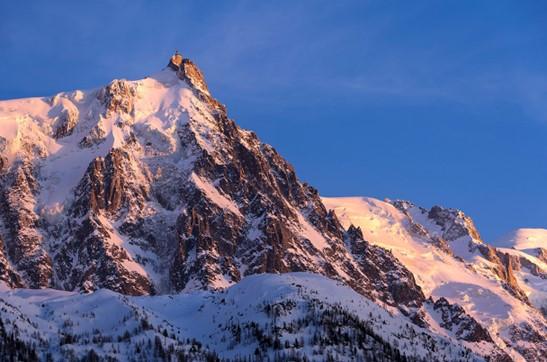Research demonstrates that climate change-induced glacial melting is increasing seismic hazard in mountainous regions. A study focused on Grandes Jorasses in the Mont Blanc massif (Alps) reveals that heatwaves accelerate glacial melt, causing meltwater to infiltrate deep underground. This pressurized water percolates into rock pore spaces and fault zones, reducing friction and triggering earthquakes. Seismic records show a significant surge in small earthquake frequency and magnitude following the 2015 heatwave, with effects delayed by 1-2 years depending on depth. This phenomenon, previously observed seasonally, is now linked to climate-driven warming trends. The mechanism, analogous to seismicity induced by fluid injection in other contexts, suggests that shrinking glaciers globally – particularly in seismically active areas like the Himalayas – could elevate earthquake risks by priming faults for rupture. While Alpine infrastructure is likely resilient, the study underscores a novel geospheric response to climate change with broader implications for seismic hazard assessment in glacier-covered ranges.

Climate change is worsening many natural hazards, including droughts, heat waves, and storm surges. Now, a new one has joined the list: earthquakes. Researchers have found that as global warming accelerates melting of mountaintop glaciers, the meltwater, percolating underground, increases the risk of damaging earthquakes.
The evidence comes from beneath Grandes Jorasses, a glacier-clad peak in the Alps that is part of the Mont Blanc massif, home to Western Europe’s tallest mountains. Precise seismic records show a heat wave in 2015 kicked off a surge of small earthquakes under the mountain. Although the tremors themselves were not damaging, the chances of large earthquakes are known to rise with the frequency of small ones. “It increases the hazard dramatically,” says Toni Kraft, a seismologist at ETH Zürich and co-author of the new study, published this month in Earth and Planetary Science Letters.
Scientists have known for decades that water, pressurized by the weight of kilometers of rock overhead, plays a key role in triggering earthquakes. When water percolates into the pore spaces of rocks, the added pressure can counteract forces that keep faults clamped shut, leading to slip. In eastern Taiwan, for example, movement along a fault—one that ruptured in a magnitude 6.8 earthquake in 2003—is thought to vary seasonally with rainfall. The same mechanism is at play in the clusters of earthquakes sometimes triggered by natural gas fracking, wastewater storage, and advanced geothermal energy projects, which all inject pressurized water deep underground.
Global warming can also release water into the ground as it melts mountain glaciers. So far, the process has not been convincingly tied to earthquakes, but the new work makes a good case, says Kwanghee Kim, a seismologist at Pusan National University. “It provides multiple lines of evidence that the geosphere is responding to climate change.”
In the Mont Blanc region, existing records already display a clear seasonal trend: Small tremors tend to rise in late summer, after meltwater from glaciers penetrates the rocks, and decrease again in early spring. But Kraft and his colleagues wanted to zoom in on the seismic record to see whether climate change was also driving a trend. “The goal is to have as unbiased a view of seismicity as possible,” Kraft says. He and his colleagues found it in records from the closest high-quality seismometer, installed in 2006 some 13 kilometers south of the mountain. It had captured more than 12,000 earthquakes previously overlooked because they were so small.
The catalog showed a clear jump in earthquake magnitude and frequency starting in 2015, after a severe heat wave melted the high alpine ice, says Verena Simon, a seismologist at ETH Zürich and the study’s lead author. The researchers then looked at weather records for other years. They found that stronger heat waves seemed to lead to bigger jumps in seismicity—albeit with a delay of a year for shallow earthquakes, and 2 years for quakes as deep as 7 kilometers. “We assume the system must have reached a triggering point,” Simon says, as meltwater found pathways through the mountains and primed more faults to rupture.
The famed 11-kilometer-long Mont Blanc tunnel had already shown how easily water can flow through the interior of Grandes Jorasses and its neighbors. Tunnel construction in the early 1960s was hampered by torrents of water. The water was fresh, lacking the minerals it would contain if it was percolating more slowly through the mountains. The excavation also revealed numerous faults, created by the collision of tectonic plates that formed the Alps, that could be conduits that ferry the water down to earthquake source zones.
When combined with the researchers’ seismic data and broader models of Alpine melt, it adds up to a “remarkably clear picture,” says William Ellsworth, a seismologist at Stanford University. Pressurized water quickly percolates to faults that are often on the verge of slipping—and sometimes pushes them over the edge. “Essentially everywhere, the Earth is in a relatively critical state,” Ellsworth says.
Additional years of data or studies that show a similar uptick elsewhere in the Alps would bolster the climate connection, says Philippe Vernant, a geodynamicist at the University of Montpellier. The seismic patterns of the Alps are tricky, he says, and other factors could be at play. For example, he says, the surge of earthquakes might represent a delayed response to the excavation of the Mont Blanc tunnel and the shift it caused in the plumbing of the mountains.
The climate-driven quakes are unlikely to threaten the tunnel or any nearby towns, Kraft says. Overall, the Alps are thought to be capable of earthquakes as big as magnitude 6—and most infrastructure is built to withstand such a quake. But other ranges including the Himalayas can experience much larger earthquakes—and are home to many melting glaciers. If this same dynamic is playing out beyond the Alps, Kraft says, scientists and communities need to start to take it into account. It seems the world’s shrinking glaciers won’t go quietly.
Sources:
SCIENCE
https://www.science.org/content/article/global-warming-triggering-earthquakes-alps .
Provided by the IKCEST Disaster Risk Reduction Knowledge Service System
Comment list ( 0 )
